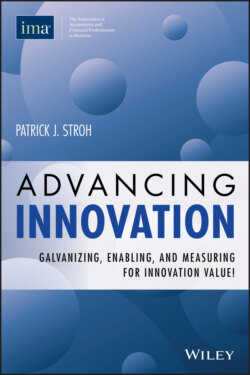Читать книгу Advancing Innovation - Patrick J. Stroh - Страница 6
На сайте Литреса книга снята с продажи.
Оглавление
Foreword
David Norton and I introduced the Balanced Scorecard in the early 1990s with several Harvard Business Review articles and a 1996 book, The Balanced Scorecard: Translating Strategy into Action. Since that time, we wrote four more books as we learned how to extend and apply this powerful framework beyond our original intent—for performance measurement— to help solve an even bigger problem that all organizations had: strategy execution. Faithful adoption of our framework and insights has enabled many organizations to achieve transformational results through successful strategy execution.
In this book, Patrick Stroh has adapted our framework for the measurement and management of innovation. Innovation has been a hot topic for some time now, confirmed in research cited in this book that an overwhelming majority (92%) of respondents feel their organization should measure and govern innovation regularly as a key business process for sustaining growth and value. Many of the respondents (71%) work in firms where senior finance and accounting leaders have been asked to support the firm’s innovation efforts.
While strategy maps and Balanced Scorecards are typically created and implemented for organizational units, Norton and I have also seen maps and scorecards created for strategic themes that cut across organizational lines.1 This enables multiple business units and functions to align around a strategic theme, such as innovation. Successful implementation of an innovation strategy is a team sport, not just the responsibility of the research and development department. It requires active collaboration of multiple units—including R&D, marketing, operations, finance, and customer service—that often find it difficult to work from the same page. That is why creating and agreeing to objectives and metrics is so powerful for aligning the organization around the execution of an innovation strategy.
I discussed with the author and his constituents about how the balanced scorecard framework can and should be applied to business innovation. Especially important is to strive to create tight causal linkages between the strategic objectives on a strategy map and associated metrics on the Balanced Scorecard. I explained why we prefer not to weight the metrics in our scorecards, except when absolutely essential, such as when linking performance to compensation. I’m pleased to see much of this counsel implemented in this book and in the associated Innovation Value Score® (IVS) measurement platform. The goal is not to use the scorecard to calculate a single measure of success for a complex strategy, but to have managers use multiple indicators to guide their company’s success in executing its business strategy, much as how a skilled pilot uses the multiple indicators in the cockpit to guide the plane for a successful journey.
I certainly support using the Balanced Scorecard framework to measure, and more importantly manage, how innovation is accomplished in your company. I hope you find the framework articulated in this book helpful, and good luck in your innovation journey.
Robert S. Kaplan
Note
1 1 Robert S. Kaplan and David P. Norton, “How to Implement a New Strategy Without Disrupting Your Organization,” Harvard Business Review, March 2006, pp. 100–109.
